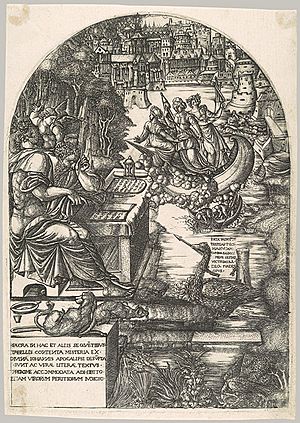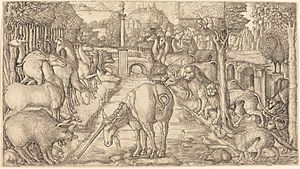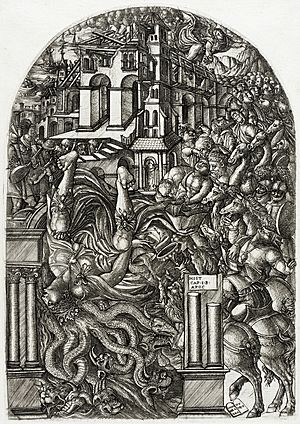Jean Duvet facts for kids
Jean Duvet (born 1485 – died after 1562) was a talented French artist. He was a goldsmith and an engraver, which means he made art by carving designs into metal plates. He is known as the first important printmaker in France. Duvet created about 73 known prints. His art has a very unique style, often described as personal and full of strong feelings. His pictures are often very crowded, but they show a lot of energy and religious meaning. Some people compare his work to that of the artist William Blake.
Contents
About Jean Duvet's Life
Jean Duvet was born in Dijon, France, in 1485. His father was also a goldsmith. In 1509, Jean became a master goldsmith in Dijon. He might have traveled to Italy around 1519, as his later prints show some Italian art influences.
His first print with a date on it was The Annunciation from 1520. Even though he lived in smaller towns, he became the official goldsmith for two French kings, Francis I and Henry II. He received his first royal appointment in 1521, when King Francis I visited Langres, where Duvet was living. Duvet helped with the decorations for the King's arrival. By 1533, he was in charge of these big events and decorations.
We don't have any of his goldsmith work today, but we know he received many orders, including from King Francis I. Jean Duvet likely died in Langres after 1562.
Was He in Geneva?
There was another goldsmith named Jean Duvet from Dijon who worked in Geneva between 1540 and 1556. Geneva was a city with different religious views at the time. Most experts now believe this was a different person, probably Jean Duvet's nephew. However, some still wonder if it was the same artist. The Jean Duvet in Langres was part of a strong Catholic group. It would have been difficult for him to live in Langres if his religious beliefs had changed.
Jean Duvet's Artworks
All 73 of Jean Duvet's prints are very rare. For example, only seven copies of his Apocalypse series with text are known to exist. Some of his individual prints are so rare that only one copy has survived. Most of his detailed and crowded prints, often with a rounded top, were likely made between 1540 and 1555. This is because the front page of his Apocalypse series is dated 1555. Some of his simpler prints are thought to be from his later years.
Duvet copied prints by other famous artists like Marcantonio and Mantegna. He used a special tool called a burin for his engravings, much like Marcantonio. He was very confident in his own artistic style, even when copying others.
The Apocalypse Series

His most famous works are a series of 23 engravings about the Apocalypse, which is a story from the Bible. The front page of this series (shown above) is dated 1555. Duvet was inspired by a famous series of woodcuts by Albrecht Dürer from 1498. However, Duvet's style is very different. His prints are crowded, sometimes a bit confusing, but they feel very urgent and powerful. Eight of his prints in this series use ideas from Dürer's compositions.
The Apocalypse series was published with text in Lyon in 1561. Many of his later prints, including these, have a rounded top shape. The front page has Latin words that say: "Jean Duvet goldsmith of Langres aged 70 made these histories 1555." This suggests it was one of the last prints he finished in the series.
The Unicorn and Other Works
Another famous work by Duvet is his series of six prints about the unicorn. These prints are also very personal but have a more gentle and dreamlike style. For a long time, people called him the "Unicorn Master" because of these beautiful prints. He also started series of prints celebrating the French kings and stories from the Genesis (the first book of the Bible), but he only made a few plates for each of these.
Jean Duvet's Unique Style
Duvet's art is very different from the fancy art made at the royal court of Fontainebleau at the time. His art often looks back to the Middle Ages with its strong religious feelings. For example, his engraving Moses Surrounded by the Patriarchs (1540–50) shows a common medieval idea: the people who came before Christ.
Duvet's art is driven by the powerful visions he wanted to show. He cared more about expressing symbolic ideas than about perfect proportions or realistic space. He also drew his texts very literally. For instance, when a text mentions a voice "as if it were a trumpet," Duvet actually draws a trumpet blasting into the ear of the saint. Even with some technical limits, the power of Duvet's vision shines through. His work also seems to hint at the more intense art that would appear later during the French Wars of Religion.
Duvet created his art in a time of strong religious excitement in Langres. He shares some artistic traits with artists like Rosso and Pontormo from Florence. These include crowded figures that might look a bit stretched, and ideas taken from Dürer. However, Duvet used more elements from older Gothic art.
Some experts have compared Duvet's art to that of William Blake (1757–1827). Both were artists who saw visions and had great confidence in their spiritual ideas. Both also had some technical challenges in their art. They were both inspired by medieval artists and by engravers from the High Renaissance. Blake might even have known about Duvet's work, as some parts of Blake's art seem to echo Duvet's.
See also
 In Spanish: Jean Duvet para niños
In Spanish: Jean Duvet para niños
- Edict of Châteaubriant



